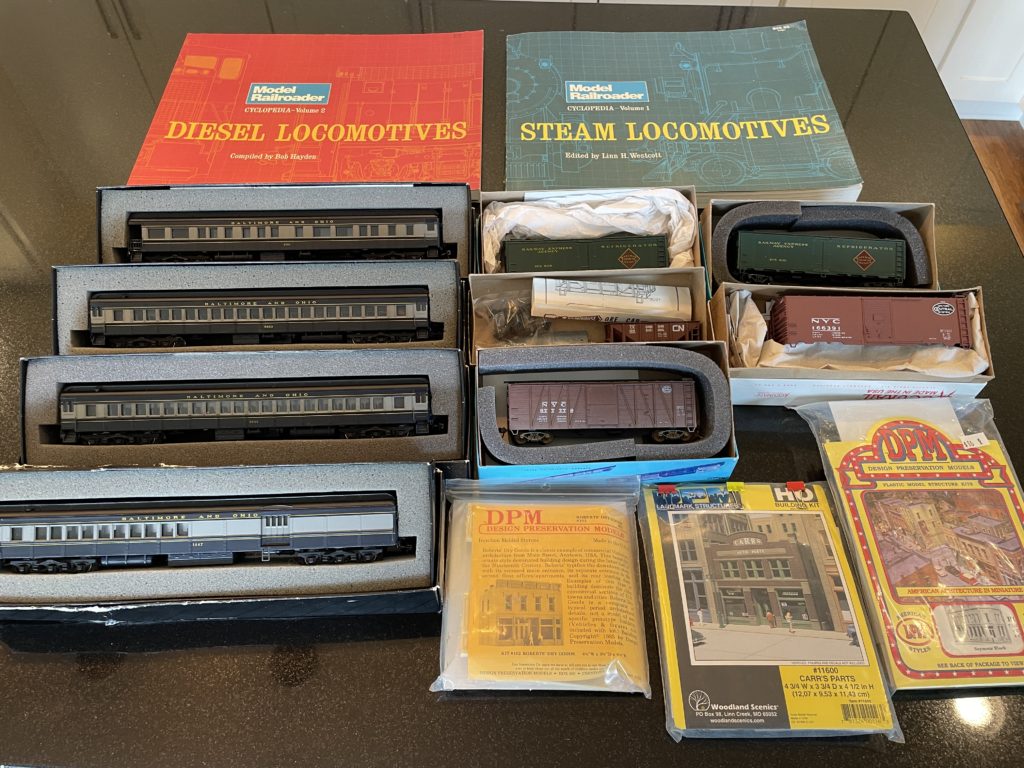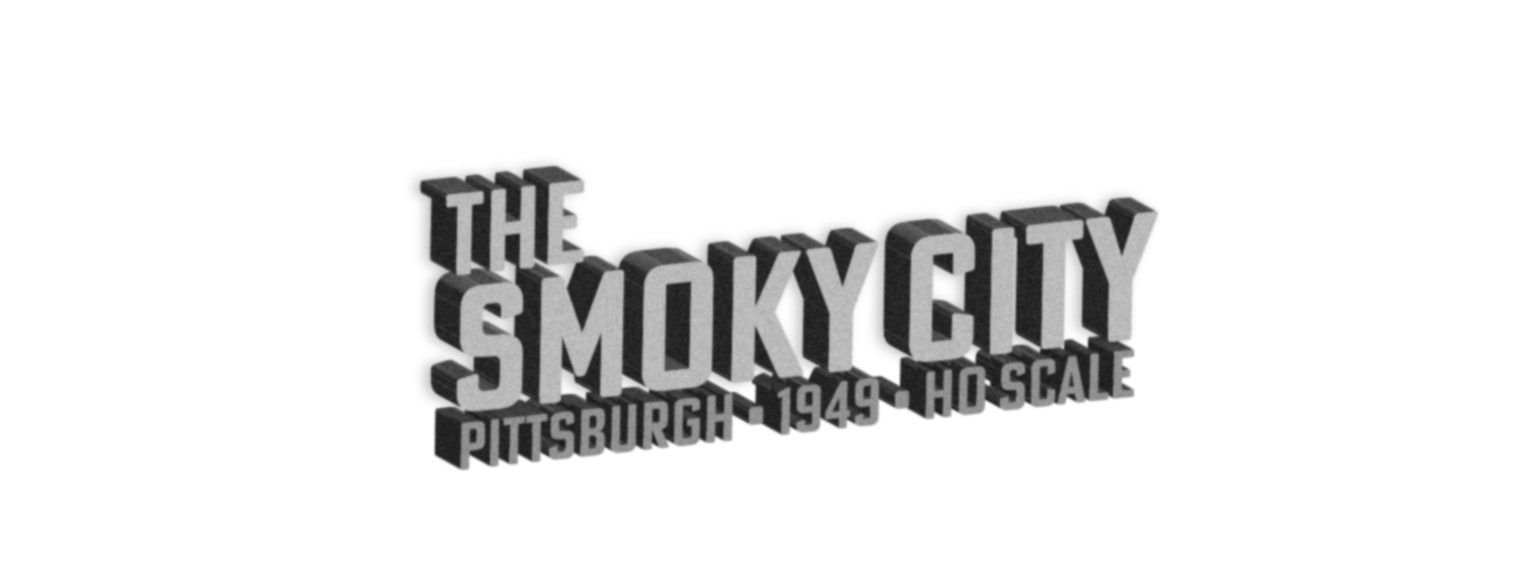Running my Athearn heavyweight passenger cars on Karl’s layout a week ago showed that they’re worse off than previously thought. My BLI Pacific, which is a pretty strong puller, slipped significantly on a couple of inclines, the steepest of which was about 2%. I knew the cars are overweight, and I knew my homemade phosphor bronze power pickups were causing drag, but I was still disappointed to see how hard it was to pull them up grades. My test runs used a consist simulating the Washingtonian (five or six cars), with a coach filling in for the combine. Two of the cars had the newer “floating brass” pickups, which I think have less drag than the others with phosphor bronze wire. The test run confirmed that I have to try loosening the wire to reduce drag.

Earlier that day, I found a good deal on four B&O heavyweight cars made by Bachmann Spectrum (in the late 90s, I think). It was two coaches, a combine and an observation car for $40. The cars are in great condition, but the lighting sucks and they have horn hook couplers. These are the same generation of models as a B&O combine I purchased in like-new condition in 2021, hoping that I could use it with my Athearn heavyweights. That was when I knew for sure that the artificially short Athearn cars look bad next to full-length models. The cars are based on PRR cars, which isn’t ideal, but still, not bad for the price.

Within days of purchasing the cars, I had already begun removing lighting from the observation car and replacing its couplers, while thinking of ways I might paint the interior detail, which is molded in a single piece of blue plastic. I started on the observation car since none of the trains I’m modeling used one, except perhaps for the occasional B&O executives passing through Pittsburgh in a business car. So, it wouldn’t be so bad if I made a big mistake or damaged the car while replacing the lighting and improving the interior. While waiting for glue to dry, I started searching the Internet to see what other B&O cars have been made more recently by Bachmann and Walthers. I made a list of all the models they made that could be used on my trains, and updated my heavyweight consist lists, where I had been keeping track of which cars I had and which ones I still needed, under my plan of using Athearn heavyweights for the two daytime operating sessions, and modern, full-length models for the trains operated in the night session. The updated list shows how many cars I’d need under a plan of using all full-length cars, and only using Athearn cars for when those cars are unavailable in full length (i.e., RPO).
The process of browsing modern heavyweight models showed me that so far, only Walthers has made accurate B&O heavyweights with AC ducts on the roofs, in affordable plastic models. I also took another look at the cars Walthers made for the Capitol Limited, with a late-50s consist, which lead me back to Dana Kawala’s review of the models in the August 2016 issue of Model Railroader. The review recommended Harry Stegmaier’s book Baltimore & Ohio Passenger Service, 1945-1971 — Volume 2: The Route of the Capitol Limited, which contains a comprehensive history of not only the Capitol Limited, but also the other B&O trains on the Washington-Chicago mainline, like the Columbian, Ambassador, Shenandoah, Chicago/Washington Express and others. I immediately found the book on eBay and bought a copy in great condition from someone in the Baltimore/Washington area. The other three B&O books I bought were very helpful in figuring out what cars and locomotives the trains had in 1949, but this one gets into the nitty-gritty, giving me lots of specific information such as car names and the types and capacity of sleeping car accommodations in 1949, and better photos of individual cars.

After reading the chapters on the Capitol Limited and the Columbian, I decided to make a list of the modern models that could be used on my HO scale Columbian, which mainly consisted of streamlined lightweight cars and an F3 A-B pair. While making the list, I found a Walthers Proto streamlined lightweight coach named McKeesport on eBay, and had to have it. Unfortunately, the seller sent me the wrong car (a lightweight streamlined diner that didn’t exist in 1949), and said he must have previously sent the McKeesport coach to someone else who never said anything about it. The diner is being returned. But now I realize the coaches were sold with a decal sheet of all the car names, so that you can put whatever town name you want on the side. Most of the models I’ve seen for sale on eBay haven’t had their name decals applied yet, so it shouldn’t be hard to get a blank car and put the McKeesport decals on it.

I then took a closer look at the smooth side lightweight streamlined B&O cars Bachmann is now selling, and purchased an Observation car. They’re higher quality models than the Bachmann Spectrum models, but they’re still not actually B&O-specific models. The observation roof, or at least the paint around the roof, is solid black, while the prototype had a ring of gray between the roof and the sides. The trucks on the Colombian were silver, while these are black. The “drum head” has the Capitol Limited logo instead of the Columbian, which I’m going to try to replace with a lighted drumhead from Tomar, which I just ordered. Maybe these models are based on the PRR prototype as well. Since it appears nobody else is making more specific models of the Columbian cars, my plan is to use Bachmann models for the observation and diner, with coaches, strata-dome and baggage-dorm from Walthers Proto, and an Athearn heavyweight RPO. Perhaps I’ll paint the trucks silver.
Unfortunately, it looks like nobody is making streamlined heavyweight B&O passenger cars, which is mainly what the Capitol Limited was using in 1949. This is a big disappointment. There are models of them made by The Coach Yard, but $800-$1,000 per car is insane. Maybe there are others. I haven’t looked much further into this yet.
Besides being the correct length, and looking better overall, the Bachman Spectrum, Bachmann Silver Series, and, presumably, Walthers and Walthers Proto cars are much more free-rolling than the Athearn heavyweights with my homemade wipers. Some of these models use metal trucks, which is how they pick up the power from the axels, without the added drag of a brass or phosphor bronze wiper. So, as of right now, I think I’ll put the brakes on acquiring and/or detailing more Athearn heavyweights, aside from RPO cars that I think I’ll still need to use. That’s not so bad, since I think it’s acceptable that an RPO car may be shorter. Detailing and upgrading them has been mostly enjoyable, but also very time-consuming, and I think I’d rather put that time and effort into my structures, rather than cars which still have big shortcomings, despite my improvements.
